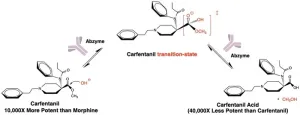(Press-News.org) As regulators and providers grapple with the dual challenges of protecting younger social media users from harassment and bullying, while also taking steps to safeguard their privacy, a team of researchers from four leading universities has proposed a way to use machine learning technology to flag risky conversations on Instagram without having to eavesdrop on them. The discovery could open opportunities for platforms and parents to protect vulnerable, younger users, while preserving their privacy.
The team, led by researchers from Drexel University, Boston University, Georgia Institute of Technology and Vanderbilt University recently published its timely work — an investigation to understand what type of data input, such as metadata, text, and image features could be most useful for machine learning models to identify risky conversations — in the Proceedings of the Association for Computing Machinery’s Conference on Human-Computer Interaction. Their findings suggest that risky conversations can be detected by metadata characteristics, such as conversation length and how engaged the participants are.
Their efforts address a growing problem on the most popular social media platform among 13-to-21-year-olds in America. Recent studies have shown that harassment on Instagram is leading to a dramatic uptick of depression among its youngest users, particularly a rise in mental health and eating disorders among teenage girls.
“The popularity of a platform like Instagram among young people, precisely because of how it makes its users feel safe enough to connect with others in a very open way, is very concerning in light of what we now know about the prevalence of harassment, abuse, and bullying by malicious users,” said Afsaneh Razi, PhD, an assistant professor in Drexel’s College of Computing & Informatics, who was a co-author of the research.
At the same time, platforms are under increasing pressure to protect their users’ privacy, in the aftermath of the Cambridge Analytica scandal and the European Union’s precedent-setting privacy protection laws. As a result, Meta, the company behind Facebook and Instagram, is rolling out end-to-end encryption of all messages on its platforms. This means that the content of the messages is technologically secured and can only be accessed by the people in the conversation.
But this added level of security also makes it more difficult for the platforms to employ automated technology to detect and prevent online risks — which is why the group’s system could play an important role in protecting users.
“One way to address this surge in bad actors, at a scale that can protect vulnerable users, is automated risk-detection programs,” Razi said. “But the challenge is designing them in an ethical way that enables them to be accurate, but also non-privacy invasive. It is important to put younger generation’s safety and privacy as a priority when implementing security features such as end-to-end encryption in communication platforms.”
The system developed by Razi and her colleagues uses machine learning algorithms in a layered approach that creates a metadata profile of a risky conversation — it’s likely to be short and one-sided, for example — combined with context clues, such as whether images or links are sent. In their testing, the program was 87% accurate at identifying risky conversations using just these sparse and anonymous details.
To train and test the system, the researchers collected and analyzed more than 17,000 private chats from 172 Instagram users ages 13-21 who volunteered their conversations — more than 4 million messages in all — to assist with the research. The participants were asked to review their conversations and label each one as “safe” or “unsafe.” About 3,300 of the conversations were flagged as “unsafe” and additionally categorized in one of five risk categories: harassment, sexual message/solicitation, nudity/porn, hate speech and sale or promotion of illegal activities.
Using a random sampling of conversations from each category, the team used several machine learning models to extract a set of metadata features — things like average length of conversation, number of users involved, number of messages sent, response time, number of images sent, and whether or not participants were connected or mutually connected to others on Instagram — most closely associated with risky conversations.
This data enabled the team to create a program that can operate using only metadata, some of which would be available if Instagram conversations were end-to-end encrypted.
“Overall, our findings open up interesting opportunities for future research and implications for the industry as a whole,” the team reported. “First, performing risk detection based on metadata features alone allows for lightweight detection methods that do not require the expensive computation involved in analyzing text and images. Second, developing systems that do not analyze content eases some of the privacy and ethical issues that arise in this space, ensuring user protection.”
To improve upon it — making a program that could be even more effective and able to identify the specific risk type, if users or parents opt into sharing additional details of the conversations for security purposes — the team performed a similar machine learning analysis of linguistic cues and image features using the same dataset.
In this instance advanced machine learning programs combed through the text of the conversations and, knowing which contact the users had identified as “unsafe,” pinpointed the words and combinations of words that are prevalent enough in risky conversations that they could be used to trigger a flag.
For analysis of the images and videos — which are central to communication on Instagram — the team used a set of programs, one that that can identify and extract text on top of images and videos, and another that can look at and generate a caption for each image. Then, using a similar textual analysis the machine learning programs again created a profile of words indicative of images and videos shared in a risky conversation.
Trained with these risky conversation characteristics, the machine learning system was put to the test by analyzing a random sampling of conversations from the larger dataset that had not been used in the profile-generation or training process. Through a combination of analyses of both metadata traits, as well as linguistic cues and image features the program was able to identify risky conversations with accuracy as high as 85%.
“Metadata can provide high-level cues about conversations that are unsafe for youth; however, the detection and response to the specific type of risk require the use of linguistic cues and image data,” they report. “This finding raises important philosophical and ethical questions in light of Meta’s recent push towards end-to-end encryption as such contextual cues would be useful for well-designed risk mitigation systems that leverage AI.”
The researchers acknowledge that there are limitations to their research because it only looked at messages on Instagram — though the system could be adapted to analyze messages on other platforms that are subject to end-to-end encryption. They also note that the program could become even more accurate if its training were to continue with a larger sampling of messages.
But they note that this proves that this work shows that effective automated risk detection is possible, and while protecting privacy is a valid concern, there are ways to making progress and these steps should be pursued in order to protect the most vulnerable users of these popular platforms.
“Our analysis provides an important first step to enable automated — machine learning-based — detection of online risk behavior going forward,” they write. “Our system is based on reactive characteristics of the conversation however our research also paves the way for more proactive approaches to risk detection which are likely to be more translatable in the real world given their rich ecological validity.”
END
Machine learning can help to flag risky messages on Instagram while preserving users’ privacy
To keep young users safe, machine learning program can spot risky conversations from metadata clues
2023-04-17
ELSE PRESS RELEASES FROM THIS DATE:
TOP advisory board welcomes new chair and members
2023-04-17
Charlottesville, VA – The Transparency and Openness Promotion (TOP) Guidelines Advisory Board welcomes its new chair, Sean Grant, and board members to support its mission to promote transparency across the research lifecycle.
Grant is a Research Associate Professor at the HEDCO Institute for Evidence-Based Educational Practice at the University of Oregon with extensive experience researching TOP as Co-Principal Investigator for Transparency of Research Underpinning Social Intervention ...
UC Irvine physicists discover first transformable nano-scale electronic devices
2023-04-17
Irvine, Calif., April 17, 2023 — The nano-scale electronic parts in devices like smartphones are solid, static objects that once designed and built cannot transform into anything else. But University of California, Irvine physicists have reported the discovery of nano-scale devices that can transform into many different shapes and sizes even though they exist in solid states.
It’s a finding that could fundamentally change the nature of electronic devices, as well as the way scientists research atomic-scale quantum materials. The study is published ...
Dixit receives 2023 Rosalind Franklin Young Investigator Award
2023-04-17
Marm Dixit, a Weinberg Distinguished Staff Fellow at Oak Ridge National Laboratory, was nominated for his work on imaging techniques for solid-state batteries.
Marm Dixit, a Weinberg Distinguished Staff Fellow at the U.S. Department of Energy’s (DOE) Oak Ridge National Laboratory, was named the 2023 recipient of the Rosalind Franklin Young Investigator Award.
Since 2004, this biannual award has been given by the Advanced Photon Source (APS) user organization. It recognizes important scientific or technical accomplishments at (or beneficial to) the APS by a young investigator, typically a senior graduate student or early career researcher. The APS is a DOE Office ...
Medical dramas influence thoughts on dangers from vaping, new Twitter analysis reveals
2023-04-17
After three popular primetime medical dramas included storylines about health harms from using e-cigarettes, hundreds of people took to Twitter to comment – including some who said they planned to quit vaping because of what they saw on the shows. A new analysis led by University of Pittsburgh School of Public Health scientists and published in the Journal of Health Communication examines the tweets for insights into the use of television shows to share public health messaging.
Following the January 2020 episodes of New Amsterdam, Chicago Med and Grey’s Anatomy that each included plots involving adolescents with vaping-associated lung-injury, ...
The Green Mediterranean / high polyphenols diet promotes dramatic proximal aortic de-stiffening, twice as much as the healthy Mediterranean diet
2023-04-17
BEER-SHEVA, Israel, April 17, 2023 – The green Mediterranean – high polyphenols diet substantially regresses proximal aortic stiffness (PAS), a marker of vascular aging and increased cardiovascular risk. The green Mediterranean diet was pitted against the healthy Mediterranean diet and a healthy guideline-recommended control diet in the DIRECT PLUS, a large-scale clinical intervention trial. Researchers found that the green Mediterranean diet regressed proximal aortic stiffness by 15%, the Mediterranean diet by 7.3%, and ...
Therapeutic can seek and destroy potent opioid to treat overdoses
2023-04-17
LA JOLLA, CA—A new therapeutic designed by Scripps Research chemists can alter the molecular structure of the potent opioid carfentanil, inactivating the opioid and reversing a carfentanil overdose. The compound, which is described in an ACS Pharmacology & Translational Science paper published on April 17, 2023, and hasn’t yet been studied in humans, works in a fundamentally different way than existing treatments for opioid overdose.
Carfentanil is up to 10,000 times more potent than morphine and 100 times stronger than fentanyl, making it one of the deadliest opioids. It is typically only used as a tranquilizer ...
No magic number for time it takes to form habits
2023-04-17
Putting on your workout clothes and getting to the gym can feel like a slog at first. Eventually, you might get in the habit of going to the gym and readily pop over to your Zumba class or for a run on the treadmill. A new study from social scientists at Caltech now shows how long it takes to form the gym habit: an average of about six months.
The same study also looked at how long it takes health care workers to get in the habit of washing their hands: an average of a few weeks.
“There is no magic number for habit formation,” says Anastasia Buyalskaya (PhD ’21), now an assistant professor of marketing at HEC Paris. Other authors ...
Cai wins 2023 Gopal K. Shenoy Excellence in Beamline Science Award
2023-04-17
Cai from Argonne’s X-ray Science division recognized for his commitment and advances in beamline science, most notably X-ray diffraction.
Physicist Zhonghou Cai is the 2023 recipient of the Gopal K. Shenoy Excellence in Beamline Science Award. He is a beamline scientist at the U.S. Department of Energy’s (DOE) Argonne National Laboratory.
The annual award recognizes active beamline scientists at the Advanced Photon Source (APS), a DOE Office of Science user facility, for significant contributions to research or instrumentation and support of the beamline user community. The APS Users Office, which grants the award, renamed it ...
AACR: Mutations in three key genes associated with poor outcomes in lung cancer patients treated with KRAS G12C inhibitors
2023-04-17
ABSTRACT: 3431
ORLANDO, Fla. ― A new study led by researchers at The University of Texas MD Anderson Cancer Center discovered that co-occurring mutations in three tumor suppressor genes – KEAP1, SMARCA4 and CDKN2A – are linked with poor clinical outcomes in patients with KRAS G12C-mutant non-small cell lung cancer (NSCLC) treated with the KRAS G12C inhibitors adagrasib or sotorasib.
The findings were presented today at the American Association for Cancer Research (AACR) Annual Meeting 2023 and published in Cancer Discovery, a journal of the AACR. This study, which encompasses the largest cohort to date of patients with KRAS G12C-mutant NSCLC treated with ...
Scientists create powerful, most-accurate tools to research deadliest blood cancer, study says
2023-04-17
New York, NY (April 17, 2023) — Tisch Cancer Center scientists have developed unique models of the deadliest blood cancer, acute myeloid leukemia (AML), creating a transformative resource to study this cancer and eventually its drug response and drug resistance. The models were described in a late-breaking abstract at the annual meeting of the American Association of Cancer Research and simultaneously published in Blood Cancer Discovery, a journal of the American Association for Cancer Research.
These are the first powerful models that are ...
LAST 30 PRESS RELEASES:
Drone sampling of whale breath reveals first evidence of potentially deadly virus in Arctic
Roman soldiers defending Hadrian’s Wall infected by parasites, study finds
Pinochet’s prisoners were tormented with music but still found solace in it, a new book reveals
Fertility remains high in rural Tanzania despite access to family planning
AI-assisted device can improve autism care access
Kinetic careers
Uncovering how parasitic plants avoid attacking themselves to improve crop resistance
Nanoparticle vaccine strategy could protect against Ebola and other deadly filoviruses
Study finds brain care score can predict risk of stroke across racial groups
Key lung immune cells can intensify allergic reactions
Do hormones explain why women experience more gut pain?
New materials conduct ions in solids as easily as in liquids
Breakthrough of the Year: Renewable energy begins to eclipse fossil fuel-based sources
LLM use is reshaping scientific enterprise by increasing output, reducing quality and more
Introducing LightGen, a chip for ultra-fast, ultra-efficient generative AI
Astronomers see fireworks from violent collisions around nearby star
ACC/AHA issue new guideline on managing congenital heart disease in adults
Cosmic crash caught on camera
Is talented youth nurtured the wrong way? New study shows: top performers develop differently than assumed
Ants: An untapped resource in the development of antibiotics?
Archaeologists use AI to create prehistoric video game
Mitochondria migrate toward the cell membrane in response to high glucose levels
Tiny viral switch offers hope against drug-resistant bacteria
Most parents aware of early peanut introduction guidelines, but confused about details
HPV vaccine can protect against severe lesions of the vulva and vagina
Virtual care provision and emergency department use among children and youth
Quadrivalent HPV vaccine and high-grade vulvovaginal lesions
Insights into dry eyes gained from stem cell-derived tear glands
Researchers identify 166 human pluripotent stem cell lines available for use in clinical applications
Europa Clipper instrument uniquely observed interstellar comet 3I/ATLAS
[Press-News.org] Machine learning can help to flag risky messages on Instagram while preserving users’ privacyTo keep young users safe, machine learning program can spot risky conversations from metadata clues




